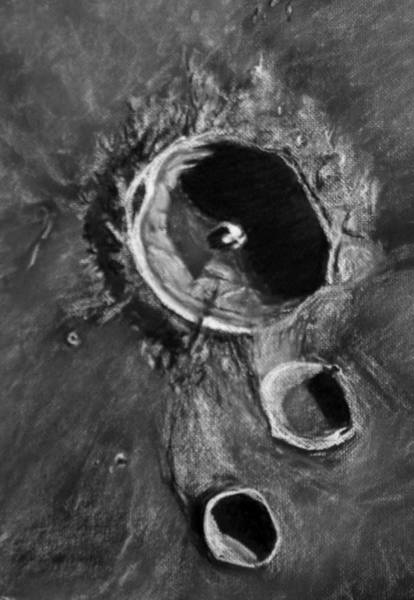Difference between revisions of "September 27, 2017"
(Created page with "__NOTOC__ =Watch Your Step!= Originally published March 16, 2008 <!-- Start of content --> <!-- ws:start:WikiTextHeadingRule:0:<h1> --> <!-- ws:start:WikiTextLocalImageR...") |
|||
| (One intermediate revision by the same user not shown) | |||
| Line 7: | Line 7: | ||
<em>image by [mailto:kraterkid@msn.com Richard Handy]</em><br /> | <em>image by [mailto:kraterkid@msn.com Richard Handy]</em><br /> | ||
<br /> | <br /> | ||
| − | Sitting in replendent isolation on the lava plains of [ | + | Sitting in replendent isolation on the lava plains of [https://the-moon.us/wiki/Mare_Nubium Mare Nubium], the magnificent 61 km [https://the-moon.us/wiki/Bullialdus Bullialdus] reflects the early morning sunlight strongly off the steep cliffs ringing it's western rim. If you were to stand on this precipice next to this face, a nervous downward gaze would reveal huge islands of collapsed rubble nearly 1800 meters of almost vertical drop below you. Wrapping around in great arcs with your field of view, on the opposite side of the crater, these giant terraces would appear as tumbled foothills rising from a deep gray plain, interrupted by the brightly lit jutting central peaks of Bullialdus. The wreath of folded crust that forms the glacis of Bullialdus is one of it's most alluring aspects. It seems replete with craggy flows of broken crustal rock arranged radially around the outer rim. As an [https://the-moon.us/wiki/stratigraphy Eratosthenian aged] crater, little is preserved of this iconic crater's once prominent ray system, but at one time it must have been quite a sight, powdery rays splayed across the long cooled Nubium flows. But time, sunlight and micrometeorites fade everything. Craters like Bullialdus are classified as complex craters. The force of the impact of the original asteriod is strong enough to distort the surface downward a few kilometers. In response to this compression, the surface rebounds almost explosively, creating extraordinay results: central peaks and rim terrace mega collapse slides. Bullialdus's peaks are close to 1000m high. The annulus of mass wasting, especially in a couple of areas to the south west of the floor do appear to almost encroach on the central peaks. To the south of Bullialdus is Bullialdus A. There seems to be a scooped depression that connects Bullialdus to it's diminutive neighbor, as if the shock of A's formation created a landslide off this section of the glacis of Bullialdus. Futher to the southwest Bullialdus B echos this odd terrain.<br /> |
<br /> | <br /> | ||
<em>Richard Handy</em><br /> | <em>Richard Handy</em><br /> | ||
Latest revision as of 17:57, 13 October 2018
Watch Your Step!
Originally published March 16, 2008

image by Richard Handy
Sitting in replendent isolation on the lava plains of Mare Nubium, the magnificent 61 km Bullialdus reflects the early morning sunlight strongly off the steep cliffs ringing it's western rim. If you were to stand on this precipice next to this face, a nervous downward gaze would reveal huge islands of collapsed rubble nearly 1800 meters of almost vertical drop below you. Wrapping around in great arcs with your field of view, on the opposite side of the crater, these giant terraces would appear as tumbled foothills rising from a deep gray plain, interrupted by the brightly lit jutting central peaks of Bullialdus. The wreath of folded crust that forms the glacis of Bullialdus is one of it's most alluring aspects. It seems replete with craggy flows of broken crustal rock arranged radially around the outer rim. As an Eratosthenian aged crater, little is preserved of this iconic crater's once prominent ray system, but at one time it must have been quite a sight, powdery rays splayed across the long cooled Nubium flows. But time, sunlight and micrometeorites fade everything. Craters like Bullialdus are classified as complex craters. The force of the impact of the original asteriod is strong enough to distort the surface downward a few kilometers. In response to this compression, the surface rebounds almost explosively, creating extraordinay results: central peaks and rim terrace mega collapse slides. Bullialdus's peaks are close to 1000m high. The annulus of mass wasting, especially in a couple of areas to the south west of the floor do appear to almost encroach on the central peaks. To the south of Bullialdus is Bullialdus A. There seems to be a scooped depression that connects Bullialdus to it's diminutive neighbor, as if the shock of A's formation created a landslide off this section of the glacis of Bullialdus. Futher to the southwest Bullialdus B echos this odd terrain.
Richard Handy
Technical Details
Date: 6-25-07 Start- 4:30 UT End- 6:00 UT
Lunation: 10.05 days
Phase: 61.1 deg
Illumination: 74.2%
Lib. in Lat.= +5 deg 56 min Lib. in Long.= -00 deg 10 min
Seeing: Antoniadi II to III
Weather: clear
Telescope: 12" SCT f/10
Bino viewer: W.O. Bino-P with 1.6X nosepiece
Eyepieces: 12.4 mm Meade Super Plossls Magnification: 393X
Medium: White and black Conte' Crayon on textured black Strathmore paper.
Sketch size: 18"x 24"
Related Links
Rükl plate 53
LPOD's: Bullialdus' Ridge Almost on the Ground Bully for Bullialdus
Note: Chuck Wood is at the Lunar & Planetary Science Conference. LPODs for March 10 through March 16 were posted by Wikispaces members. Thanks to all who participated!
Yesterday's LPOD: The Lunar South Pole
Tomorrow's LPOD: Fly Me To the Moon
COMMENTS?
Register, Log in, and join in the comments.



